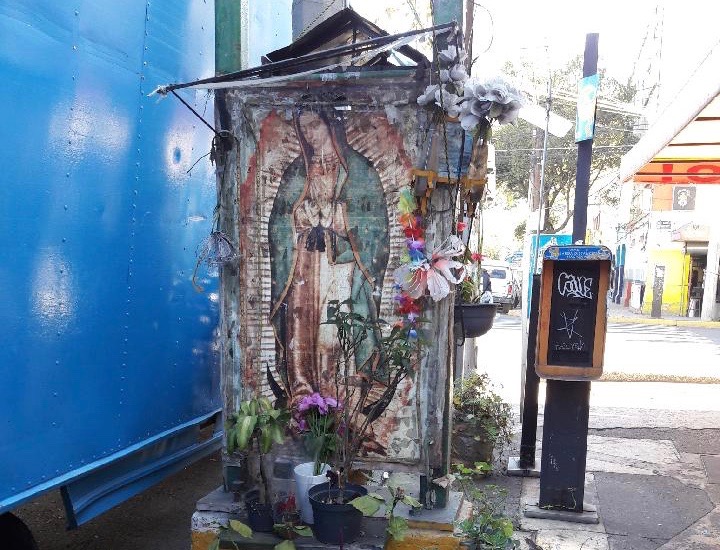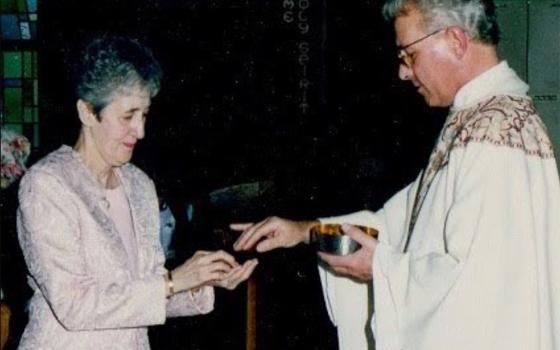
A sidewalk shrine to Our Lady of Guadalupe in Mexico City (Michael A. Cipolla)
Every year on December 12th Latin@ Catholics, particularly those of Mexican-American descent, gather in their homes and plazas to celebrate the feast of Our Lady of Guadalupe, Patron Saint of Mexico and Patroness of the Americas. This popular Catholic feast falls during the season of Advent and is unique in so far as the image of Guadalupe is one of the few Marian images where Mary does not carry the Christ-child in her arms, but rather, appears as an expectant pregnant woman with child in her womb. In this sense, the celebration of Guadalupe fittingly summarizes the central meaning of the season of Advent, namely, that time of the year when Christians prepare to celebrate the God who came into this world as a human and from a woman, and stood in solidarity with the marginalized and oppressed. Just as the beloved disciple, traditionally identified as John, stands with Mary at the foot of Jesus' cross (Jn. 19: 25-27), Guadalupe stands in solidarity with Juan Diego and all God's creatures at the hour when they face their greatest threat of "crucifixion" and various forms of "extinction."
This year, the celebration of Guadalupe carries special significance given the recent release of the Fourth National Climate Assessment Report and the warning signs this report raises with respect to our planet, which Pope Francis argues in Laudato Si' has begun "to look more and more like an immense pile of filth" (21).The story of Guadalupe offers a Christian signpost for turning this pile of filth into a pile of beautiful red roses. Here, we recount God's vision for a new creation that affirms survival through creaturely interdependence and the ethical responsibility each of us must embrace to take the side of the Juan Diegos of this world, those creatures who often are the first to suffer the consequences of our unethical human actions (human as well as other creatures).
The report
The assessment report was produced by a significant number of federal and non-federal experts, including scientists, government officials, Indigenous communities, national laboratories, universities and various voices within the private sector. The summary findings section contains the following twelve points that convey the urgency of why we must act now to save our common home in order to permit life for its future inhabitants:
- Climate change creates new risks and exacerbates existing communal vulnerabilities
- Without substantial and sustained global mitigation and regional adaptation efforts, climate change is expected to cause growing losses in infrastructure and property
- Climate change affects the natural, built, and social systems we rely on individually and through their connections to one another.
- While mitigation and adaptation efforts have expanded substantially in the last four years, they do not yet approach the scale considered necessary to avoid substantial damages to the economy, environment, and human health over the coming decades.
- The quality and quantity of water available for use by people and ecosystems across the country are being affected by climate change, increasing risks and costs to agriculture, energy production, industry, recreation, and the environment.
- Impacts from climate change on extreme weather and climate-related events, air quality, and the transmission of disease through insects and pests, food, and water increasingly threaten the health and well-being of the American people, particularly populations that are already vulnerable.
- Climate change increasingly threatens Indigenous communities' livelihoods, economies, health, and cultural identities by disrupting interconnected social, physical, and ecological systems.
- Without substantial and sustained reductions in global greenhouse gas emissions, transformative impacts on some ecosystems will occur; some coral reef and sea ice ecosystems are already experiencing such transformational changes.
- Without substantial and sustained reductions in global greenhouse gas emissions, transformative impacts on some ecosystems will occur; some coral reef and sea ice ecosystems are already experiencing such transformational changes.
- Without adaptation, climate change will continue to degrade infrastructure performance over the rest of the century, with the potential for cascading impacts that threaten our economy, national security, essential services, and health and well-being.
- Coastal communities and the ecosystems that support them are increasingly threatened by the impacts of climate change. Without significant reductions in global greenhouse gas emissions and regional adaptation measures, many coastal regions will be transformed by the latter part of this century, with impacts affecting other regions and sectors.
- Outdoor recreation, tourist economies, and quality of life are reliant on benefits provided by our natural environment that will be degraded by the impacts of climate change in many ways.
The story of Guadalupe
The Nican Mopohua is a story that narrates the encounter in 1531 between the Amerindian Juan Diego and Our Lady of Guadalupe at Mount Tepeyac, a place sacred to the native inhabitants of Mexico. Central to the story are the life-giving interactions between Juan Diego, who does not see himself worthy and deserving of this encounter, and Guadalupe who the story portrays as God's ambassador of life to the oppressed. Like the second story of creation (Genesis 2:4-3:24), the story of Guadalupe invites us to consider the interdependence of all life and the life-threatening consequences of abusing power with respect to human creatures and all creation. The story takes place at the time of Conquest when indigenous communities, their landscapes and the cultural and religious traditions associated with their daily living have been erased from history. The story speaks to the detrimental effects of human indifference that threatens creaturely life on our planet, as cultures, creatures and even persons themselves become objects within a "throw-away" cultural ideology.
Advertisement
The story of Guadalupe affirms what Pope Francis characterizes in his encyclical as an "integral ecology" (10). The story links the fate of the threatened life of human persons (the life of Juan Diego, that of his ailing uncle, and all other indigenous peoples) to their ravaged lands. Sinful human agency that results from the Conquest affects all God's creatures. But Guadalupe comes to offer God's hope of creaturely relationships in the form of a request: Guadalupe sends Juan Diego on mission to the local bishop to request the building of a common home (Church) where all could receive "love, compassion, help, and salvation."

Various private shrines to Our Lady of Guadalupe (Michael A. Cipolla)
Even those familiar with this story might often miss the point that the story of Guadalupe is really less about the construction of a physical building, and more about a new creation rooted in right relationship with God and neighbor — a calling out to build inclusive community to house and sustain life for all God's creatures (ekklesia). As the story makes amply clear, Guadalupe comes pregnant with life for a people and a land threatened with extinction. In the process of communicating with this marginalized people within their sacred but vanquished landscape, these creatures experience a "resurrection." The singing of birds in the land of flowers at the beginning of the story that draw Juan Diego into his mystical-like encounter with Our Lady of Guadalupe anticipate the climactic moment at the end of the story when Juan Diego, in Christ-like manner, gathers the courage to speak truth to power. The gift of roses he carries in his tilma from our Lady of Guadalupe become the sign (the image of Guadalupe) for the bishop to listen to the cry of the poor, echoing the words of the Gospel: "This is my beloved Son, with whom I am well pleased; listen to him" (Matt. 17.5). Simply stated, the inter-personal and inter-creaturely encounter mediated through the beauty of flower and song that the image of Guadalupe offers becomes the Nahuatl word in which God's Word of grace incarnates a people, interrupts their unsustainable status quo, and effects a creative, life-giving, and inclusive way of relating among all God's creatures.
An Advent call to action
Yes, roses can emerge from the midst of a wintry season. Yes, we can begin to clean up our filthy garden, lower carbon dioxide, and bridge the "emissions gap" that continues to grow between global pollution and international efforts to stop and reverse its life-threatening effects. And yes, as Catholics who embrace both faith and reason, we must not simply rely on what we believe with respect to climate change, but we must also take very seriously the observations of scientists who have made it perfectly clear that unless we act, and act immediately, our common home and all of its inhabitants, beginning with those most vulnerable, will find themselves increasingly under threat of "extinction."
In one of his reflections entitled "Advent," Karl Rahner observed that it is a strange thing that "At the beginning of our preparation for Christmas, the gospel [Luke 21:25-33] is about the end of the world." Yet, this should not surprise us because while Christian hope invites us to trust that Christ has already triumphed over all attempts to extinguish life, Christians must also be keenly aware that for God, human agency matters. At the "end" of time, as Rahner rightly observes in this reflection on Advent, "One voice will come out" of Christ's mouth to judge what we did and what we failed to do. And that voice will surely be Guadalupan-like, asking us to consider how we accompanied or failed to accompany the Juan Diegos of this world and what we did or failed to do to preserve "the roses," life within our common home.
[Miguel H. Díaz is the John Courtney Murray University Chair in Public Service at Loyola University in Chicago. He was ambassador to the Holy See during the first administration of President Barack Obama.]
Editor's note: We can send you an email alert every time a Theology en la Plaza column is posted to NCRonline.org. Go to this page and follow directions: Email alert sign-up.







